Managing Application Directories and Configuring the Application Path
|
How to: |
|
Reference: |
Procedures and the synonyms they use reside in application directories. The Application Path is a list of viewable application directories. It determines their order of appearance in the navigation pane.
The Application Path is the default search criteria for the server. The server searches each of the directories listed in the Application Path sequentially to find the requested procedure or synonym.
By default, the server profile (EDASPROF.PRF) is run for all users when they connect to the DataMigrator Server to provide access to all application directories in the server search path.
However, you can control a user's access to application directories by creating individual user profiles. Each user can then:
- Access only the application directories specified in the Application Path specified for that profile.
- Use synonyms and procedures in the specified Application Path.
Grouping procedures and synonyms into application directories provides better control. For your convenience, three directories are included in the server search path during installation:
- baseapp is included in the search path for every user profile the DM administrator creates. This directory cannot be removed.
- ibisamp is the default location for sample files you can use to create procedures, as well as sample procedures.
- foccache is a special directory that allows you to create and reuse files for the duration of your Data Management Console session, or until the maximum retention time is reached (set by the server administrator).
You can, of course, set up additional application directories in the server search path.
The following operations are available from the Application Directories folder by right-clicking in the DMC or Web Console.
- Creating sample procedures and data.
- Setting up application directory mappings for different user profiles.
- Configuring the application path by adding, removing, or reordering application directories.
- Filtering the procedures or synonyms that appear in the application directories.
- Creating new procedures and synonyms.
You can also use the Configure Application Path window to set the viewable directories for DataMigrator, as well as add new directories and mappings. To use DM procedures that reside in a directory other than ibi\apps\baseapp, the directory must be added to the list of viewable directories.
You can also manage application directories and configure the Application Path from the Applications page of the Web Console. For more information, see the Server Administration manual or the Web Console online help.
Note: The instructions in the next several sections are for changing the server profile (edasprof.prf), which applies to all users. However, each user can also have their own profile which is used If security is enabled on the server. An Application Administrator can, by default, change their own application path. A Server Administrator can also change the application path of any user.
To change the application path of a user, expand the Access Control and then Roles folder. Expand the user's role folder and right-click on user's ID and click Application Path. On the Application Path Configuration panel, click Change Profile Preference and select a value other than Inherit from previously executed profiles.
Procedure: How to Create an Application Directory
- In the navigation pane, right-click Application Directories, point to New, and then
click Application Directory.
The Create New Application dialog box opens, as shown in the following image.
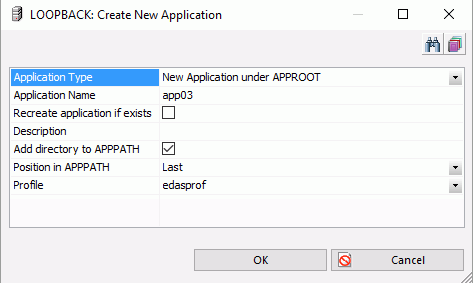
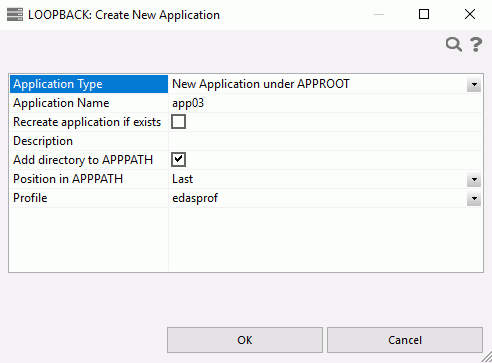
- Enter
the name of the new application directory, and, optionally, a description.
Leave the Add directory to APPPATH check
box selected.
Caution: The directory name may not contain spaces, special characters, or capital letters. Capital letters are converted to lowercase. If an application directory is created outside of the DMC or Web Console, the same rules apply.
- Click OK.
Procedure: How to Remove an Application Directory From the Application Path
- Right-click Application Directories in
the navigation pane and click Application Path.
The Application Path Configuration dialog box opens, as shown in the following image.
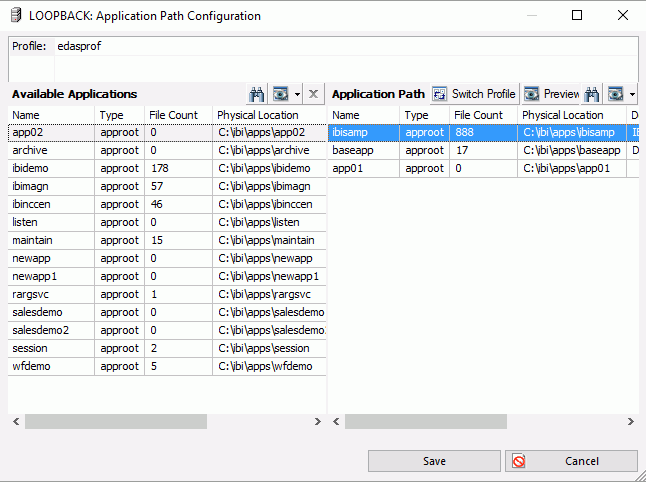
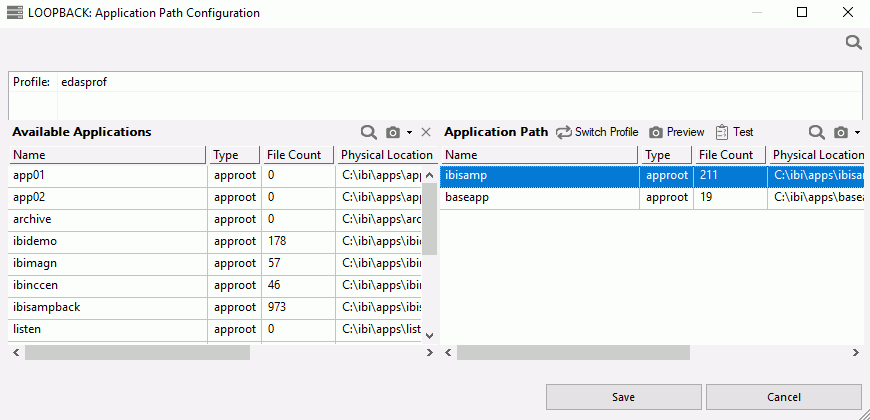
- Find the application directory you wish to delete. Right-click the path and click Remove from path.
- Click Save.
Procedure: How to Delete an Application Directory
Note: You must be connected to a server from a Server Administration ID.
- If the application directory is still located in the application path, remove it. For more information, see How to Configure the Application Path.
- Right-click Application
Directories and click Application Preferences.
- Select the Show Applications not in PATH check box.
- Skip this step if Hide Application Directories not in PATH is the available option.
- If neither option appears, make sure you are connected to the server from a Server Administration ID.
- Click Update.
- Expand the Inactive Directories folder in the navigation pane.
- Right-click the directory you want to delete and click Delete.
- In the Confirm dialog box, click OK.
Procedure: How to Add Application Directory Mappings
You can create a new mapping to a directory anywhere in the file system and include it in the server path. Application directory mappings can be added and deleted on a per profile basis.
- Right-click Application
Directories in the navigation pane, point to New, and
then click Application Directory.
The Create New Application dialog box opens.
- From
the Application Type drop-down menu, select Application
Mapping to Disk.
Additional options appear in the Create New Application dialog box, as shown in the following image.
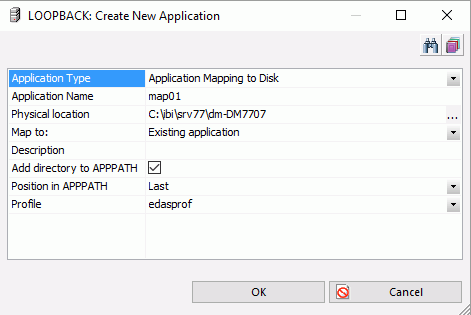
- In the Application Name box, type an application name of up to 64 characters.
- In the Physical location box, enter the full path of the physical directory to be mapped, in the format required by your platform. If needed, select Create application if it does not exist from the Map to drop-down menu.
- Optionally, enter a description in the Description field.
- Optionally, select the Add directory to APPPATH check box.
- If you select Add directory to APPPATH, you can also select from the Position in APPPATH and Profile drop-down menus.
- Click OK.
The new mapping appears in the Application Configuration dialog box.
Procedure: How to Delete Application Directory Mappings
- In the navigation pane, right-click Application Directories and click Application Path.
The Application Path Configuration dialog box opens.
- Find the mapping you wish to delete. Right-click it and click Remove from Path.
- Click Save.
- Click OK to confirm the deletion.
Procedure: How to Configure the Application Path
You must add an application directory or mapping to the Application Path for it to be accessible.
- In the navigation pane, right-click Application Directories and click Application Path.
The Application Path Configuration dialog box opens.
- Click Switch Profile to select the profile of the user whose Application Path you wish to set.
- To add a directory or mapping to the application path, right-click it in the Available Applications section and click Add to Path.
- Optionally, right-click any directory or mapping you want to remove from the application path and click Remove from Path. This allows you to remove the directory or mapping from the path without deleting it completely.
- Set
the directory search order by dragging a directory or mapping to its desired position.
You may want to consider moving the ibisamp directory to the bottom of the list to avoid confusion. If you do not plan to use the sample data, you can remove ibisamp from your Application Path completely.
- When you have added and arranged all necessary directories and mappings, click Save.
- Click OK in the confirmation dialog box.
- Right-click Application
Directories in the navigation pane and select Refresh to
see the directory or mapping in the tree.
Note: If there is a long list of application directories, you can click the Find button on the top right or use Ctrl + F to find a text string in the name, physical location, or description.
Reference: Application Directories Shortcut Menu Options
If you right-click Application Directories in the DMC navigation pane, the following shortcut menu options are available:
- Refresh
-
Refreshes the application directories tree.
- Explorer
-
Opens a Windows Explorer style window on the right side of the Data Management Console that shows detailed information about the currently selected server object.
- New
-
Allows you to add tutorials, flows, procedures, synonyms, and files on the server.
- Search Files
-
Allows you to search on a number of parameters, including file name, extension, description, and content, as well as set filtering criteria.
- Sort by
-
Allows you to sort by name, size, type, and modify date.
- Application Preferences
-
Allows you to set preferences for how objects in an application directory appear. You can select whether to show subdirectories last, show applications not in the path, and show object statistics.
- Application Settings
-
Opens an Application Settings dialog box that allows you to set settings for the foccache and home application root directories.
- Manage External Repository
-
This feature is not available in DataMigrator.
- Application Path
-
Allows you to add and delete application directories and mappings from the application path.
- Create My Home
-
Allows you to create a home application folder.
- Schedule and E-mail
-
Has the following options:
- Scheduler Agents. This report runs for the user whose ID value is stored in the sched_scan_id of a Scheduler. The Scheduler must be active to run the Scheduler Agents report.
- Scheduled Events. Opens a dialog box that shows all jobs
scheduled to run during a specified time range.
The Scheduler must be active to run the Scheduler Events report.
This report shows all flows and procedures scheduled to run during the time period you selected. The Run Date and Run Time columns show their scheduled run times.
The User ID column shows the user ID used when running the flow or procedure:
- sched_run_id
-
Shows what user ID the flow is run under.
- user
-
The user ID that saved the flow or procedure.
- server_admin_id
-
The first server administrator ID.
- Force Scheduler Scan. Forces the scheduler to rescan the directories immediately, in order to find and run any new or changed flows or procedures according to their schedules.
- Log and Statistics
-
Opens the Log and Statistics dialog box that enables you to view a log or statistics report.
The following options are available:
- Report Type
-
Allows you to select either a log or statistics report.
- Report Range
-
Allows you to select to view the last report, all reports, or a report specified within a select time range.
- Completion Status
-
Allows you to view all reports, all completed reports, all successfully completed reports, or all completed reports that contained errors.
- Run by
-
Allows you to view reports for all flows, including those initiated by the scheduler or submitted manually. This includes flows initiated from the DMC, WC, and CMRUN.
- Application or Flow Name
-
Allows you to select a specific application or flow name for the report.
- Impact Analysis
-
Opens a sub-menu that allows you to view impact analysis reports.
- Tutorials
-
Opens the Create Tutorial Framework dialog box that allows you to create sample procedures and data for DataMigrator. For more information, see How to Create Sample Procedures and Data.
- Refresh
-
Refreshes the application directories tree.
- Explorer
-
Opens a Windows Explorer style window on the right side of the Data Management Console that shows detailed information about the currently selected server object.
- New
-
Allows you to add tutorials, flows, procedures, synonyms, and files on the server. For more information on creating same procedures and data using the Tutorials option, see How to Create Sample Procedures and Data.
- Preferences
-
Allows you to set preferences for how objects in an application directory appear. You can select whether to show subdirectories last, show applications not in the path, and show object statistics.
- Create My Home
-
Allows you to create a home application folder.
- Impact Analysis
-
Opens a sub-menu that allows you to view impact analysis reports.
- Manage
-
Has the following options:
- Settings
-
Opens an Application Settings dialog box that allows you to set settings for the foccache and home application root directories.
- External Repository
- Application Path
-
Allows you to add and delete application directories and mappings from the application path.
- Schedule and E-mail
-
Has the following options:
- Scheduler Agents. This report runs for the user whose ID value is stored in the sched_scan_id of a Scheduler. The Scheduler must be active to run the Scheduler Agents report.
- Scheduled Events. Opens a dialog box that shows all jobs
scheduled to run during a specified time range.
The Scheduler must be active to run the Scheduler Events report.
This report shows all flows and procedures scheduled to run during the time period you selected. The Run Date and Run Time columns show their scheduled run times.
The User ID column shows the user ID used when running the flow or procedure:
- sched_run_id
-
Shows what user ID the flow is run under.
- user
-
The user ID that saved the flow or procedure.
- server_admin_id
-
The first server administrator ID.
- Force Scheduler Scan. Forces the scheduler to rescan the directories immediately, in order to find and run any new or changed flows or procedures according to their schedules.
- Log and Statistics
-
Opens the Log and Statistics dialog box that enables you to view a log or statistics report.
The following options are available:
- Report Type
-
Allows you to select either a log or statistics report.
- Report Range
-
Allows you to select to view the last report, all reports, or a report specified within a select time range.
- Completion Status
-
Allows you to view all reports, all completed reports, all successfully completed reports, or all completed reports that contained errors.
- Run by
-
Allows you to view reports for all flows, including those initiated by the scheduler or submitted manually. This includes flows initiated from the DMC, WC, and CMRUN.
- Application or Flow Name
-
Allows you to select a specific application or flow name for the report.
| WebFOCUS | |
|
Feedback |